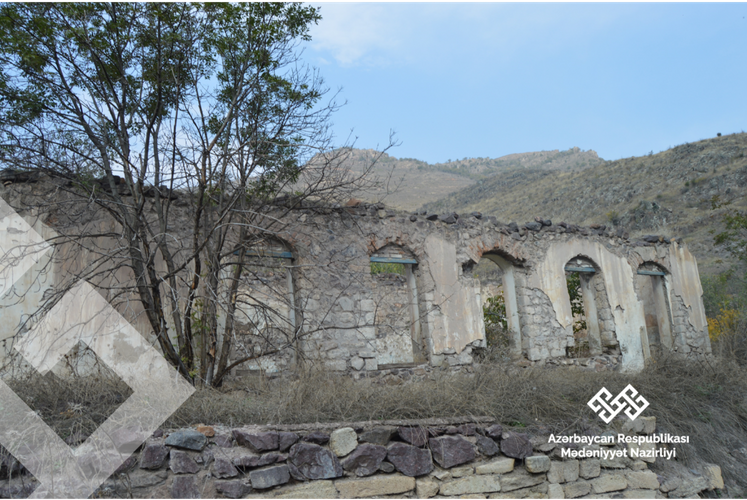Monitoring of monuments and cultural institutions has begun for the initial inventory and protection of historical and cultural objects (monuments and enterprises) in accordance with the Decree of the President of the Republic of Azerbaijan No. 1170 of October 29, 2020 “On organization of temporary special management in the liberated territories of the Republic of Azerbaijan” by representatives of the Ministry of Culture of the Republic of Azerbaijan in the liberated territories of the Republic of Azerbaijan, the Ministry of Culture told APA.
312 state-registered historical and cultural monuments were monitored during the process.
In addition, 106 unregistered historical, architectural and archeological objects (newly discovered monuments) located in these areas were discovered.
The monitoring also revealed 571 cultural institutions, including 286 libraries, 237 culture houses and clubs, 19 museums, 24 children's music schools, 1 cinema, 2 theaters and 2 galleries. Almost all enterprises are in a state of complete destruction.
"The inventory process has had to fill a gap due to the lack of fact-finding missions to be carried out by international organizations, including UN specialized agencies, over the past 30 years.
The current monitoring allowed to determine the illegal actions of the Republic of Armenia against historical and cultural monuments as a result of 30 years of occupation, and the situation in which these territories were handed over.
Unfortunately, mosques, madrassas, bridges and temples in the liberated territories were not only destroyed, but in many cases used inappropriately, insulting the national moral values of our people.
Here, Haji Alakbar mosque, Dadali, Merdinli, Gejagozlu, Yukhari Veysalli village mosques in Fuzuli region, two mosques in Horadiz village, Suleymanli and Papi village mosques in Jabrayil region, Mamar and Yusifbeyli village mosques in Gubadli region, Zangilan city mosque, Malatkeshin and Zangilan village mosques in Zangilan region should be especially noted.
Four 19th-century tombs, including the tomb of Ugurlu Bey, a local architectural monument located in the Garaagaj cemetery, were completely destroyed.
It was determined that the tombs of Panahali khan (XIX century) and Mehdigulu khan located in Aghdam were destroyed and the monuments were seriously damaged by the occupying Armenia. The tomb of Ibrahimkhalil khan (19th century) was completely destroyed.
The most destroyed examples of immovable cultural heritage by the Armenian armed forces were Islamic religious monuments, ie mosques, tombs and other places of worship.
The Republic of Armenia has demonstrated its hatred for Azerbaijanis by keeping pets, including pigs, inside mosques belonging to our people. Such an attitude towards the rich cultural heritage of the occupied territories, as well as unique monuments of special importance, is a threat to world heritage.
The destruction of places of worship and the use of pigs as a place of detention is a clear example of Armenian vandalism, and the attitude to the cultural heritage of the world and our country in the example of these monuments should be condemned by international organizations and foreign countries. This reflects the attitude of the Republic of Armenia to other religions and its true face.
Illegal excavations were organized by the Armenian leadership near the Azykh cave in Khojavend region and Shahbulag castle in Aghdam region by fake archeological expeditions, including foreign experts. At the same time, the Armenian side resorted to another provocation, falsifying the history of the monument in the Upper Govhar Agha Mosque in Shusha under the guise of "restoration" work, claiming that this historical building belonging to our people was a Persian mosque. The goal was to pit the two neighboring and friendly nations against each other.
The vandalism of the Armenian side manifested itself not only in Muslim historical and religious monuments, but also in Christian historical and religious monuments. Thus, many temples belonging to Caucasian Albania, including the Khudavang and Ganjasar monasteries in the Kalbajar region, were appropriated and vandalized. The fresco on the east wall of the Arzu Khatun Church of the Khudavang Monastery, which is considered the pearl of the Khudavang Monastery, was cut and removed by special methods. As a result of illegal repair work carried out in Ganjasar monastery, its ancient appearance was damaged.
Along with architectural and archeological monuments, garden-park, monumental and memorial monuments were destroyed by the Republic of Armenia. Thus, the monuments to our compatriots killed in the 1941-1945 war in Gubadli, Fizuli and Agdam were completely destroyed. The statue of Mohammad Fuzuli in Fizuli, the memorial museum of Sari Ashig in Gulabird village of Lachin region, the bust of Molla Panah Vagif in Shusha, the tombstone of the poet Natavan in Aghdam were destroyed.
Such acts of vandalism by the Armenian side against cultural facilities have grossly violated the provisions of many international documents, including the Convention for the Protection of Cultural Property in the Event of Armed Conflict, adopted in The Hague in 1954, European Convention on the Protection of the Archaeological Heritage, Convention, international protection of the world cultural and natural heritage.
"We are confident that the Armenian military-political leadership will be held accountable and punished for the destruction, misappropriation and misuse of historical and cultural monuments belonging to the Azerbaijani people," reads the statement of the Ministry.


